傲慢与偏见舞会分析·英国文学史论文
《傲慢与偏见》与爱情与等级的古典舞会

《傲慢与偏见》与爱情与等级的古典舞会在英国文学史上,简·奥斯汀的经典之作《傲慢与偏见》被誉为最受欢迎的浪漫小说之一。
该小说不仅揭示了当时英国社会的等级制度,还以精湛的文笔展现了爱情的复杂与曲折。
其中,古典舞会是小说中重要的环节,它不仅扮演着推动情节发展的角色,还揭示了与等级相关的社会规范和爱情的挑战。
本文将探讨《傲慢与偏见》中古典舞会对爱情与等级的影响。
古典舞会在《傲慢与偏见》中被描述为英国上层社会最重要的社交场合之一。
对于拥有贵族背景的家庭而言,参加古典舞会意味着社会地位的确认和社交地位的维持。
而对于那些处于社会底层的人来说,古典舞会则是展示自己的机会,为他们提供了与上层社会互动的渠道。
在小说中,波克尔夫妇一家在乡村举办了一场盛大的古典舞会,引起了本地居民们的广泛关注。
此时,达西先生和宾利先生这样的上层贵族也应邀前来参加。
舞会中,达西的出场引起了众人的注目,不仅因为他的高贵出身,还因为他尽显傲慢和骄傲态度。
与此相反,本地的乔治安娜小姐虽然不如达西富有和受人追捧,却以其美丽和温柔的气质吸引了参会者的目光。
通过这场舞会,小说中的等级观念得以凸显。
无论是乔治安娜的出现还是达西的傲慢态度,人们都能感受到社会等级对于人们之间关系的影响。
爱情在这样一个特定的社交场合中产生,进一步突出了等级对于爱情发展的制约。
小说中的女主角伊丽莎白·班内特在舞会上与达西相遇,两人初次交谈并没有留下好印象。
事后,达西对自己的态度感到遗憾,表示了对伊丽莎白不当判断的歉意。
然而,在爱情与等级的交织中,他们之间的关系并没有迅速发展。
爱情需要克服等级观念的束缚,他们之间的隔阂在舞会上并没有得到彻底解决。
此外,古典舞会也揭示了女性在当时英国社会中的局限。
小说中的女性角色们被要求出席舞会,以进行相亲和寻找适婚对象。
然而,女性们并没有享有和男性一样的社交自由和选择权。
她们需要循规蹈矩地参加舞会,按照社会礼仪与男性互动。
傲慢与偏见毕业论文

傲慢与偏见毕业论文傲慢与偏见毕业论文《傲慢与偏见》是奥斯丁的代表作。
这部作品以日常生活为素材,一反当时社会上流行的感伤小说的内容和矫揉造作的写作方法,分享了傲慢与偏见的毕业论文,一起来看看吧!一、导论(一)研究综述《傲慢与偏见》中的婚姻话题一直以来为人们乐此不疲地谈论着,下面是前人对该书婚姻的分析:不管是贝内特夫妇还是夏洛特和柯林斯夫妇,他们的婚姻的出发点都是钱。
在当时工业革命的大潮下,人们疯狂地追逐名利地位,形成了经济第一的观念,同时却忽略了对妇女的教育,把她们框在狭小的家庭生活圈内,限制了她们的受教育权利。
因此,没有多少财产的年轻女性在那样的金钱社会中唯一的生存机会就是嫁个有钱人。
这种资本主义婚姻的实质无非就是金钱和利益的结合,缺少了情感因素这一基本保障,在日久经年的婚姻生活中虽然衣食无忧,但必定缺少了应有的快乐,也体会不到何谓幸福的婚姻。
(二)本文的研究视角和研究目的《傲慢与偏见》作为世界经典名著,被毛姆列为世界十大小说名著之一,其文学价值自然不言而喻。
因此,多年来,对该书的解读和研究从未中断过。
不管是对奥斯丁本人的研究,还是对书中各个人物的解读,或是对该书文学艺术的考究,都深刻地反映了《傲慢与偏见》作为世界上经久不衰的一部作品有其独特的魅力。
本文从婚姻这一角度深入研究书中四对青年男女的婚姻状况,讨论影响人们幸福婚姻的因素到底有哪些。
是爱情?是金钱?还是社会地位?仁者见仁,智者见智,不同的人对幸福的理解不同,自然对婚姻的选择也不尽相同。
本文提倡爱情是婚姻最根本的要素,也是婚姻最重要的条件,当然一定的物质基础与婚姻的幸福指数也密切相关。
通过对书中四对婚事的探讨,以及它们对当代人的影响,最后笔者总结了爱情才是缔结一段美好婚姻的最重要的因素。
二、《傲慢与偏见》中不同性质的婚姻(一)理想的婚姻:伊莉莎白与达西1.真爱的结合伊莉莎白与达西的感情纠葛贯穿了整部小说。
伊莉莎白是贝内特太太的二女儿,不仅美貌出众,而且聪明过人。
傲慢与偏见论文
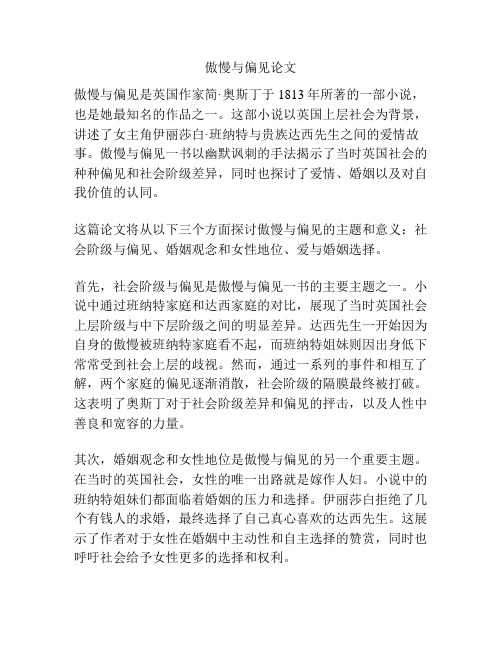
傲慢与偏见论文傲慢与偏见是英国作家简·奥斯丁于1813年所著的一部小说,也是她最知名的作品之一。
这部小说以英国上层社会为背景,讲述了女主角伊丽莎白·班纳特与贵族达西先生之间的爱情故事。
傲慢与偏见一书以幽默讽刺的手法揭示了当时英国社会的种种偏见和社会阶级差异,同时也探讨了爱情、婚姻以及对自我价值的认同。
这篇论文将从以下三个方面探讨傲慢与偏见的主题和意义:社会阶级与偏见、婚姻观念和女性地位、爱与婚姻选择。
首先,社会阶级与偏见是傲慢与偏见一书的主要主题之一。
小说中通过班纳特家庭和达西家庭的对比,展现了当时英国社会上层阶级与中下层阶级之间的明显差异。
达西先生一开始因为自身的傲慢被班纳特家庭看不起,而班纳特姐妹则因出身低下常常受到社会上层的歧视。
然而,通过一系列的事件和相互了解,两个家庭的偏见逐渐消散,社会阶级的隔膜最终被打破。
这表明了奥斯丁对于社会阶级差异和偏见的抨击,以及人性中善良和宽容的力量。
其次,婚姻观念和女性地位是傲慢与偏见的另一个重要主题。
在当时的英国社会,女性的唯一出路就是嫁作人妇。
小说中的班纳特姐妹们都面临着婚姻的压力和选择。
伊丽莎白拒绝了几个有钱人的求婚,最终选择了自己真心喜欢的达西先生。
这展示了作者对于女性在婚姻中主动性和自主选择的赞赏,同时也呼吁社会给予女性更多的选择和权利。
最后,爱与婚姻选择是傲慢与偏见的核心主题之一。
小说中的伊丽莎白和达西两人一开始对彼此存在偏见和误解,但通过相互交流和了解,最终发展出深厚的爱情。
这展示了奥斯丁对于爱情和婚姻的理解,认为爱情应该建立在相互了解、尊重和平等的基础上,而不是单纯地基于社会地位或金钱。
奥斯丁通过班纳特家庭和达西家庭的故事,传达了对于真爱和婚姻的理想追求。
总之,傲慢与偏见是一部揭示社会阶级差异、探讨婚姻观念和女性地位、呼吁自由爱情和婚姻选择的经典小说。
通过对小说中主要主题的探讨和分析,可以更深入地理解和欣赏这部作品中所展现的社会问题和人性品质。
傲慢与偏见情节分析

傲慢与偏见情节分析《傲慢与偏见》是简·奥斯汀创作的经典小说,以描绘早19世纪英国上层社会的婚姻观念和人际关系为主题。
本文将对小说中的情节进行分析,探讨其中的傲慢与偏见如何影响人物命运和故事发展。
第一部分:达西先生的傲慢与伊丽莎白的偏见小说中最为著名的情节之一便是达西先生与伊丽莎白·班纳特之间的相识和相爱。
而达西先生一直以来都以其高傲的姿态而为人所知,对社会地位较低的人瞧不起。
这种傲慢的态度首先在伊丽莎白第一次见到达西时就得到了体现,伊丽莎白被他的傲慢给深深触动。
而同样,伊丽莎白也以其个性化的偏见预先评判了达西的人品。
然而,在后续的故事中,随着两人的交流和相互了解,他们的傲慢与偏见逐渐被打破,最终走到了一起。
这一情节的发展展示了傲慢与偏见可以通过相互沟通和理解而被战胜的事实。
第二部分:家族傲慢与爱情观在《傲慢与偏见》中,作者通过不同家庭的傲慢态度展现了当时英国社会上层对婚姻的看法。
班纳特家的傲慢源自他们过度强调自己的家庭背景和地位,以为这能使其女儿顺利嫁入上流社会,同时也看不起社会地位较低的人。
相反,达西家的傲慢则体现在他们对地位和财富的过分追求,认为只有家族的地位和社会地位相当的人才能与之结婚。
在小说中,这种傲慢态度给人物的爱情观带来了不小的问题。
例如,班纳特家对达西兄妹的傲慢态度,使得达西先生一度拒绝了对简·班纳特的追求,直到了解到简的真心才最终悔过自新。
傲慢的家族背景和对社会地位的过度追求,导致了许多不幸的婚姻和错失的机会。
第三部分:对外界的偏见与误解除了傲慢与偏见在感情上的影响外,小说还展示了对他人的偏见和误解对人物命运的影响。
小说中的人物普遍对他人产生了主观的印象,并以此为基础对他们做出判断。
这种偏见和误解使得人物之间的交流和理解变得困难。
例如,伊丽莎白一开始对达西的种种行为有偏见,以为他是个冷酷无情的人。
而达西对伊丽莎白的家庭背景也抱有偏见,无法接受要与她结婚。
文学论文:浅谈《傲慢与偏见》中叙述视角和写作意义

⽂学论⽂:浅谈《傲慢与偏见》中叙述视⾓和写作意义相关推荐⽂学论⽂:浅谈《傲慢与偏见》中叙述视⾓和写作意义 [摘要]英国⼥作家简·奥斯丁的⼩说《傲慢与偏见》在叙述诗学上彰显出了某种⾃觉意识。
通过建构⼀种“有意味的形式”,⼩说改写了传统男性叙事⽂本⾥⼥性被对象化、客体化的存在状况,传达出向来被遮蔽的⼥性主体意识。
关键字:奥斯丁《傲慢与偏见》叙述诗学⼥性写作 英国⼥作家简·奥斯丁的⼩说以流利清新和细致敏锐⽽著称,具有超越时空的永恒魅⼒。
⼆零零五年拥有七百多名会员的英国浪漫⼩说家协会,投票评选出五部英语⼩说中的经典浪漫作品,奥斯丁的《傲慢与偏见》位居榜⾸,其次是《简·爱》《飘》《蝴蝶梦》和《呼啸⼭庄》。
近期的英国⼴播公司的⼀项读者调查表明,多数⼥性认为《傲慢与偏见》是“最能改变⼥性对⾃⼰评价的⼀部⽂学作品”。
⽂学经典的不朽,就在于它们总是能够在不同的时代对于不同的读者显⽰多重意蕴,这⼤概即是⿊格尔所说的“每⼀件艺术品都是和观众中每⼀个⼈所进⾏的对话”①的具体内涵。
接受美学认为,⽂学⽂本是召唤性的语符结构,具有“意义”空⽩和“含义”不确定性,隐含着多种阐释和评价的可能性, 召唤着鉴赏主体去发现⽂本的潜在意义。
故对任何⽂学⽂本的诠释和解读,实际上是⼀个不断发掘⽂本意义的过程,亦即⼀个不断解放能指的过程。
有关《傲慢与偏见》的评述可谓汗⽜充栋,然⽽,对于⼩说⽂本独出机的叙述策略和拒绝传统写作范式的⽂学史意义,却⼀直未能得到深⼊的分析。
⼥性写作建⽴在两个基础之上,⼀是作者为⼥性,⼆是传达了⼥性意识。
英国⼥性解放的潮流滥觞于⼗九世纪中叶,故⽽⼀般认为,⾃维多利亚时代的夏洛蒂·勃朗特以降,⽂学才开始从⼥性的⾓度、观点来描写⽣活,⼥性作为创作主体进⼊⽂学领域,⽽直到⼗九世纪中后期,⼥性作品的主体意识才得以凸现出来。
其实第⼀次让⼩说中的⼥性形象成为真正意义上的主⾓,已然在作品中传达出初步的⼥性主体意识,英国⼥作家中当属简·奥斯丁。
傲慢与偏见一场又一场的舞会,一直跳到幸福来临

傲慢与偏见一场又一场的舞会,一直跳到幸福来临今年是简·奥斯丁(Jane Austen,1775—1817)逝世200周年。
很多人喜爱这位英国女作家,如果没有她的《傲慢与偏见》,我们简直不想学英语了。
简年轻之际家境中落,父亲是牧师,对她说,世上最屈辱之事便是贫穷。
简努力写作,艰辛挣扎。
她认识一个家境优越的男子,双方都有意愿,可是阶层不同,对方家长嫌她出身,对她说:“你写作?写完之后有什么用?”简也不想拖累别人,这段感情最终不了了之。
200年前,简·奥斯丁在《傲慢与偏见》里展现让女儿攀上一门有钱人的思想,其实,在今天仍然普遍存在,阶层从没有消失。
简·奥斯丁用细鹅毛笔沾着墨水在一张张纸片上轻笔疾书,用她幽默反讽风格的文字,写出了六部长篇小说,诞生了英国19世纪初英国乡村生活百科全书。
她所在的摄政时期前期,外界已经天翻地覆,革命如火如荼,然而平静的乡村依然平静,女孩子们日复一日地做着寻觅如意郎君的美梦。
“静女其姝,俟我于城隅。
爱而不见,搔首踟蹰。
”一年有10000英镑收入的达西先生与小乡绅的女儿伊丽莎白小姐两颗心若隐若现,距离时远时近,达西焦虑万状也好,搔首踟蹰也罢,一切尽在不言之中,他们一系列漫长的误会,也让我们为之捏一把汗。
好在,愤怒的敌意让位于不可抗拒的吸引,小说人物都能如愿以偿地圆满结局,简是女性,舍不得以悲剧结局啊!看《傲慢与偏见》肯定会被十八世纪末英国乡村舞会所吸引。
简擅长在“二寸象牙”上细细刻画摄政时期英国各阶层的生活细节,一场一场的舞会是小说中不可或缺的推动情节发展的重要场景。
事实上,舞蹈中的一个旋转,一个矜持或暧昧的眼神或动作都可能影响到以后的婚姻关系,小说里的每一个细节也都无形地在推动情节的发展。
当时年轻人之间的接触是被严格控制的,但有这样一个地方,调情,亲密动作和肢体接触是被允许的,甚至被鼓励的,那就是舞会。
在舞会上,可以邂逅一段曼妙时光,享受63道名菜甜品的款待,更重要的是可以知晓很多八卦与秘密。
奥斯丁傲慢与偏见赏析论文(中英对照版本)
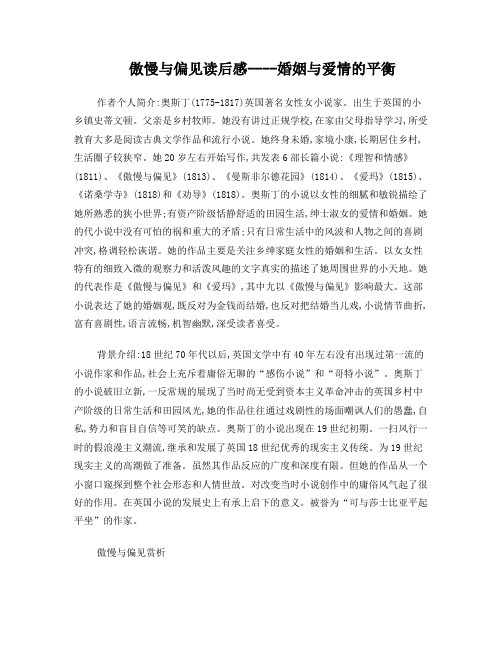
傲慢与偏见读后感----婚姻与爱情的平衡作者个人简介:奥斯丁(1775-1817)英国著名女性女小说家。
出生于英国的小乡镇史蒂文顿。
父亲是乡村牧师。
她没有讲过正规学校,在家由父母指导学习,所受教育大多是阅读古典文学作品和流行小说。
她终身未婚,家境小康,长期居住乡村,生活圈子较狭窄。
她20岁左右开始写作,共发表6部长篇小说:《理智和情感》(1811)、《傲慢与偏见》(1813)、《曼斯非尔德花园》(1814)、《爱玛》(1815)、《诺桑学寺》(1818)和《劝导》(1818)。
奥斯丁的小说以女性的细腻和敏锐描绘了她所熟悉的狭小世界;有资产阶级恬静舒适的田园生活,绅士淑女的爱情和婚姻。
她的代小说中没有可怕的祸和重大的矛盾;只有日常生活中的风波和人物之间的喜剧冲突,格调轻松诙谐。
她的作品主要是关注乡绅家庭女性的婚姻和生活。
以女女性特有的细致入微的观察力和活泼风趣的文字真实的描述了她周围世界的小天地。
她的代表作是《傲慢与偏见》和《爱玛》,其中尢以《傲慢与偏见》影响最大。
这部小说表达了她的婚姻观,既反对为金钱而结婚,也反对把结婚当儿戏,小说情节曲折,富有喜剧性,语言流畅,机智幽默,深受读者喜受。
背景介绍:18世纪70年代以后,英国文学中有40年左右没有出现过第一流的小说作家和作品,社会上充斥着庸俗无聊的“感伤小说”和“哥特小说”。
奥斯丁的小说破旧立新,一反常规的展现了当时尚无受到资本主义革命冲击的英国乡村中产阶级的日常生活和田园风光,她的作品往往通过戏剧性的场面嘲讽人们的愚蠢,自私,势力和盲目自信等可笑的缺点。
奥斯丁的小说出现在19世纪初期。
一扫风行一时的假浪漫主义潮流,继承和发展了英国18世纪优秀的现实主义传统。
为19世纪现实主义的高潮做了准备。
虽然其作品反应的广度和深度有限。
但她的作品从一个小窗口窥探到整个社会形态和人情世故。
对改变当时小说创作中的庸俗风气起了很好的作用。
在英国小说的发展史上有承上启下的意义。
毕业论文 傲慢与偏见
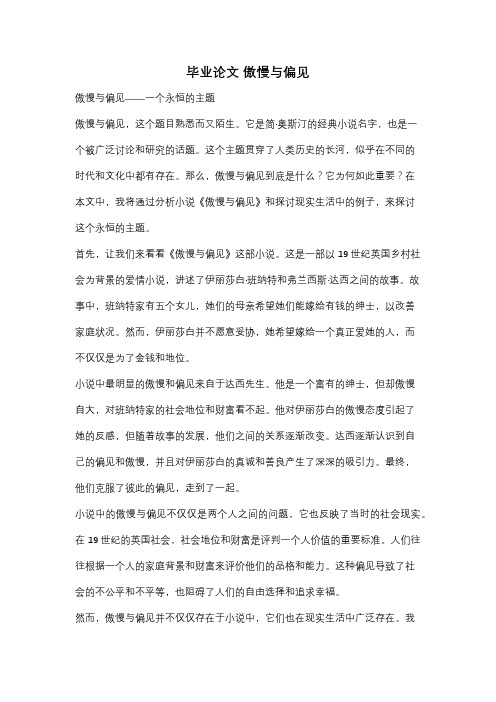
毕业论文傲慢与偏见傲慢与偏见——一个永恒的主题傲慢与偏见,这个题目熟悉而又陌生。
它是简·奥斯汀的经典小说名字,也是一个被广泛讨论和研究的话题。
这个主题贯穿了人类历史的长河,似乎在不同的时代和文化中都有存在。
那么,傲慢与偏见到底是什么?它为何如此重要?在本文中,我将通过分析小说《傲慢与偏见》和探讨现实生活中的例子,来探讨这个永恒的主题。
首先,让我们来看看《傲慢与偏见》这部小说。
这是一部以19世纪英国乡村社会为背景的爱情小说,讲述了伊丽莎白·班纳特和弗兰西斯·达西之间的故事。
故事中,班纳特家有五个女儿,她们的母亲希望她们能嫁给有钱的绅士,以改善家庭状况。
然而,伊丽莎白并不愿意妥协,她希望嫁给一个真正爱她的人,而不仅仅是为了金钱和地位。
小说中最明显的傲慢和偏见来自于达西先生。
他是一个富有的绅士,但却傲慢自大,对班纳特家的社会地位和财富看不起。
他对伊丽莎白的傲慢态度引起了她的反感,但随着故事的发展,他们之间的关系逐渐改变。
达西逐渐认识到自己的偏见和傲慢,并且对伊丽莎白的真诚和善良产生了深深的吸引力。
最终,他们克服了彼此的偏见,走到了一起。
小说中的傲慢与偏见不仅仅是两个人之间的问题,它也反映了当时的社会现实。
在19世纪的英国社会,社会地位和财富是评判一个人价值的重要标准。
人们往往根据一个人的家庭背景和财富来评价他们的品格和能力。
这种偏见导致了社会的不公平和不平等,也阻碍了人们的自由选择和追求幸福。
然而,傲慢与偏见并不仅仅存在于小说中,它们也在现实生活中广泛存在。
我们可以从各个方面找到例子来说明这一点。
比如,一些人在面对不同文化和背景的人时,会因为自己的优越感而表现出傲慢和偏见。
他们认为自己的文化和价值观是正确的,而其他文化和价值观则是错误的。
这种傲慢和偏见导致了文化冲突和社会分裂。
此外,傲慢与偏见还经常在职场和教育领域中出现。
一些人会因为自己的职位和地位而对下属或学生表现出傲慢和偏见。
傲慢与偏见毕业论文
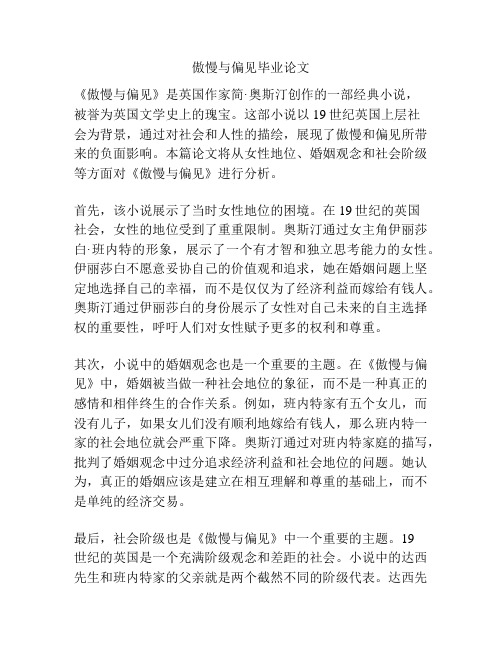
傲慢与偏见毕业论文《傲慢与偏见》是英国作家简·奥斯汀创作的一部经典小说,被誉为英国文学史上的瑰宝。
这部小说以19世纪英国上层社会为背景,通过对社会和人性的描绘,展现了傲慢和偏见所带来的负面影响。
本篇论文将从女性地位、婚姻观念和社会阶级等方面对《傲慢与偏见》进行分析。
首先,该小说展示了当时女性地位的困境。
在19世纪的英国社会,女性的地位受到了重重限制。
奥斯汀通过女主角伊丽莎白·班内特的形象,展示了一个有才智和独立思考能力的女性。
伊丽莎白不愿意妥协自己的价值观和追求,她在婚姻问题上坚定地选择自己的幸福,而不是仅仅为了经济利益而嫁给有钱人。
奥斯汀通过伊丽莎白的身份展示了女性对自己未来的自主选择权的重要性,呼吁人们对女性赋予更多的权利和尊重。
其次,小说中的婚姻观念也是一个重要的主题。
在《傲慢与偏见》中,婚姻被当做一种社会地位的象征,而不是一种真正的感情和相伴终生的合作关系。
例如,班内特家有五个女儿,而没有儿子,如果女儿们没有顺利地嫁给有钱人,那么班内特一家的社会地位就会严重下降。
奥斯汀通过对班内特家庭的描写,批判了婚姻观念中过分追求经济利益和社会地位的问题。
她认为,真正的婚姻应该是建立在相互理解和尊重的基础上,而不是单纯的经济交易。
最后,社会阶级也是《傲慢与偏见》中一个重要的主题。
19世纪的英国是一个充满阶级观念和差距的社会。
小说中的达西先生和班内特家的父亲就是两个截然不同的阶级代表。
达西先生是一个富有的贵族,而班内特的父亲则是一个只有微薄收入的乡村绅士。
奥斯汀通过这两个角色的相互交往,揭示了社会阶级观念对人们的态度和行为的影响。
小说通过达西先生的傲慢和伊丽莎白的偏见,告诫读者们不要因为社会地位的不同而对他人产生偏见,要真正去了解和尊重他人。
综上所述,《傲慢与偏见》通过对女性地位、婚姻观念和社会阶级的描写,传达了作者对当时社会存在的问题的批判和反思。
这部小说通过生动的人物形象和细致入微的情节,让读者深入思考和反思,引发了对社会和人性的思考和探讨。
英国小说鉴赏_傲慢与偏见鉴赏论文[1]
![英国小说鉴赏_傲慢与偏见鉴赏论文[1]](https://img.taocdn.com/s3/m/013bc1d8a58da0116c174913.png)
傲慢与偏见鉴赏论文摘要:《傲慢与偏见是》是简.奥斯汀的代表作,也是奥斯汀作品中最受欢迎的一部长篇小说。
这不小说中有许多亮点:其一,里面有四段婚姻,这四段婚姻基本概括了当时社会中爱情和婚姻的状况,通过对四种不同婚姻和爱情的描写,解析和探讨,充分体现了作者的爱情和婚姻观。
其二:采取了讽刺的手法描写了里面的人物,贯穿于整个故事的结构之中。
关键词:不动声色的讽刺,傲慢,偏见,个性,结构,英国乡镇生活。
这部小说以日常生活为素材,一反当时社会上流行的感伤小说的内容和矫揉造作的写作方法,生动地反映了保守和闭塞事情的英国乡镇生活。
小说发生在英国乡村,贝纳特家的五个女儿待嫁闺中,两位贵族先生的出现,民兵团的到来,给他们原本平静的田园生活带来了一些不平凡的意义。
小说开头那句“每一个有钱的单身汉,都得娶一位太太,这就像一条举世公认的真理。
”已经是脍炙人口的名句了。
小说中“母亲”形象的班纳特太太给人留下了深刻的印象。
作者将她描述为:“一个智力贫乏,孤陋寡闻,喜怒无常的女人。
她生平最大的事就是把女儿们嫁出去。
”的确,在一个男尊女卑的现象十分严重的社会中,班纳特家中只有女儿,没有男嗣,因而,班纳特家的财产不得不由班纳特先生的侄子继承。
这样致使班家小姐的嫁妆只有从其母亲当年的嫁妆中分得,嫁妆的卑微常常使的年轻的小姐们不得不选择通过婚姻来为自己将来的温饱作打算,自然会将婚姻视为金钱至上的买卖。
难怪郡里一旦来了一位有钱的绅士,班纳特太太便认定他为自己的准女婿。
贯穿整部小说的几个婚姻故事,既有关于伊丽莎白好友夏洛特的,又有关于她自己姐妹的婚姻,但仔细思考看来,这几个婚姻故事其实是为了衬托出伊丽莎白的爱情。
如夏洛特和柯林斯尽管婚后过着舒适的物质生活,但他们之间没有爱情。
柯林斯不仅为人做作、举止粗俗,唯一可取的便是溜须拍马之功。
但他可以继承班纳特家的财产,且自己有一份田地和一份牧师的俸禄。
在文中柯林斯曾很明确地说过自己结婚的三个理由。
《傲慢与偏见》中的戏剧性特色论文[精选5篇]
![《傲慢与偏见》中的戏剧性特色论文[精选5篇]](https://img.taocdn.com/s3/m/3d605fc9f9c75fbfc77da26925c52cc58bd690f2.png)
《傲慢与偏见》中的戏剧性特色论文[精选5篇]第一篇:《傲慢与偏见》中的戏剧性特色论文论文摘要:本文从情节结构、人物塑造、舞台场景、叙事角度四个方面对简·奥斯丁的代表作《傲慢与偏见》进行了较为详细的阐述,剖析该作品神奇的戏剧性特色。
论文关键词:小说《傲慢与偏见》戏剧性特色四个方面小说《傲慢与偏见》是英国批判现实主义作家简·奥斯丁(JaneAusten)的代表作。
这部作品以日常生活为素材,通过对婚姻问题的描写,生动地反映了18世纪末19世纪初处于保守和闭塞状态下的英国乡镇生活和世态人情。
奥斯丁因为长期居住在封建保守势力较强的农村,生活圈子十分狭窄,所以她的小说的取材范围较小,她常把故事的背景放在有三四家大户的乡镇上。
但在她熟悉的范围之内,她写得非常精确细致,后人常以她自称其作品为“三寸牙雕”来评价她的作品,可见其观察之敏锐,笔触之细腻。
我认为除了其作品的细致之外,奥斯丁的伟大之处还在于她的绝妙的戏剧力量。
本文尝试从以下四个方面入手来分析该作品的戏剧性特色。
1.情节结构《傲慢与偏见》的故事讲的是18世纪末19世纪初英国某乡镇上某乡绅家的几个女儿的恋爱和结婚。
主线是二女儿伊丽莎白因少年绅士达西的傲慢,对他产生很深的偏见,后来又消除了偏见,和他相爱,成为眷属。
小说以伊丽莎白的行动为叙述中心来展开情节,与此成网状的辅助情节线形成平行对照:吉英与彬格莱的相爱与结婚,柯林斯的求婚与夏绿蒂的联姻,伊丽莎白与韦翰的那段短暂的感情纠葛,以及韦翰与丽迪雅的私奔及至最终结合,甚至班纳特先生与太太的婚姻状况都无不与主要情节发生着密不可分的关系,它们或以自身的单薄、苍白丰富反衬了“达伊”主线,或以内在的联系催化了“达伊”主线的进展。
这些“插曲”都处在相对固定的空间中的直线时间延伸过程中的某一点。
而主要情节的纵向发展无疑也是小说戏剧特征的一个方面。
所以《傲慢与偏见》也像戏剧那样,有一个严密的布局,既没有不必要的人物,又没有不必要的情节,整个故事的发展都是环环相扣的。
文学毕业论文傲慢与偏见外国文学论文
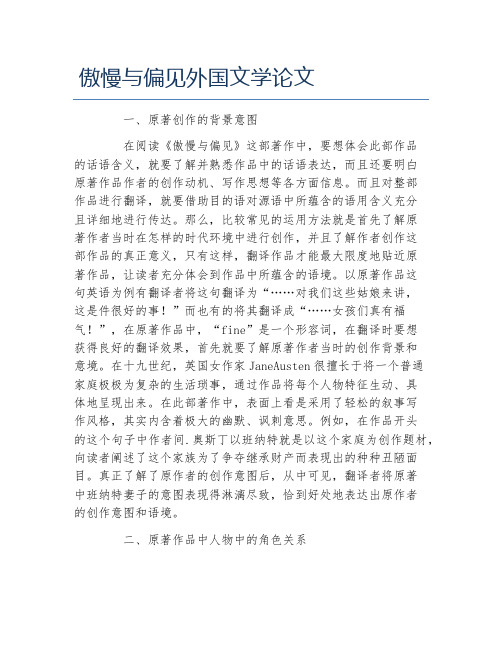
傲慢与偏见外国文学论文一、原著创作的背景意图在阅读《傲慢与偏见》这部著作中,要想体会此部作品的话语含义,就要了解并熟悉作品中的话语表达,而且还要明白原著作品作者的创作动机、写作思想等各方面信息。
而且对整部作品进行翻译,就要借助目的语对源语中所蕴含的语用含义充分且详细地进行传达。
那么,比较常见的运用方法就是首先了解原著作者当时在怎样的时代环境中进行创作,并且了解作者创作这部作品的真正意义,只有这样,翻译作品才能最大限度地贴近原著作品,让读者充分体会到作品中所蕴含的语境。
以原著作品这句英语为例有翻译者将这句翻译为“……对我们这些姑娘来讲,这是件很好的事!”而也有的将其翻译成“……女孩们真有福气!”,在原著作品中,“fine”是一个形容词,在翻译时要想获得良好的翻译效果,首先就要了解原著作者当时的创作背景和意境。
在十九世纪,英国女作家JaneAusten很擅长于将一个普通家庭极极为复杂的生活琐事,通过作品将每个人物特征生动、具体地呈现出来。
在此部著作中,表面上看是采用了轻松的叙事写作风格,其实内含着极大的幽默、讽刺意思。
例如,在作品开头的这个句子中作者间.奥斯丁以班纳特就是以这个家庭为创作题材,向读者阐述了这个家族为了争夺继承财产而表现出的种种丑陋面目。
真正了解了原作者的创作意图后,从中可见,翻译者将原著中班纳特妻子的意图表现得淋漓尽致,恰到好处地表达出原作者的创作意图和语境。
二、原著作品中人物中的角色关系原著在人物对话中语言的应用表达得比较微妙,在翻译原作品中的人物对话时,要准确把握是相当不易的。
因此,在翻译时,翻译者要掌握好说话者和听话者两者之间的角色关系。
原著作者在对话中采用了非常高超的语言艺术,充分刻画出作品中人物之间存在的矛盾,并较为生动地描写了人物性格特征。
例如,在这句话中:“Ihvaeellverdesie rdyuorgoodopinioll,andyouhavecertainlybesttoweditmosunwillingly。
傲慢与偏见的论述

经典真题·感悟中考一、(2012·丽水中考)阅读下面这篇文章,完成1~4题。
将自己切成一颗钻石孙君飞①传统的钻石工艺一般只能将一颗钻石切到57面,后来只有少数的工艺大师能够突破这个数字。
他们不但技艺超群,而且浑身是胆,否则是没有勇气将一颗钻石推到美的巅峰的。
②玉不琢,不成器。
对于人生,我们理应抱着不断雕刻自我的态度,最终才能成材、成功。
③拥有青春的人更应该视自己为一颗等待完美切出的钻石,因为年轻人胆气最足,站在人生的开端,前方又呈现出诸多可能。
如果仅仅做到一种可能,是对生命的很大浪费。
青春绝不是一个削足适履、故步自封的过程,而是一个不断打破模子、百变新生的过程。
一根木头也许雕刻一刀就承受不了了,而一块璞玉就需要雕刻更多刀,才能够呈现出一个完整的层面。
对于一颗钻石来讲,即便切上许多刀,也是远远不够的。
57刀似乎够了,但恰恰有人切出了80多刀,于是一个惊世传奇诞生了,正在人们啧啧赞叹时,又有一个人切出了100多刀,这难道不是更大的奇迹吗?所以,如果你是一颗钻石,就不能将自己当做一块璞玉,更不能当做一根木头,而要根据自己的特质,不断地发现自己、成长自己、收获自己,这才是对人生真正负责的态度,才算没有辜负了大好青春。
④退一步来讲,即便我们永远做不了一颗钻石,如同我们也许永远做不了达·芬奇式的完美天才,也并不妨碍我们将一件事情、一项工作、一份事业做成一颗钻石。
台湾年轻演员桂纶镁就是这样经营着自己的演艺事业,通过自我较劲、自我拧巴、自我叫板,终于让她的事业呈现出不同的切面,赢得了特立独行不同质的赞誉。
有人评论她是《不能说的秘密》里的氧气美女,也是《线人》里的黑帮阿嫂,是《女人不坏》里的朋克女郎,也是《全球热恋》里的神经质女生……她一直在颠覆自己、挑战自己,当我们渐渐淡忘了她最初的模样时,她又携着《肩上蝶》强势回归清纯校园风。
⑤我们不妨将桂纶镁看做青春奋斗者的一个榜样,她不但勇敢地打破了传统演艺路线的桎梏,而且成功地呈现了崭新的青春风采,告诉我们哪怕只做一件事情,只要敢于不断切割它、创造它,同样会带来更多可能、更多精彩。
《傲慢与偏见》中的社交舞会

《傲慢与偏见》中的社交舞会社交舞会在《傲慢与偏见》这部经典小说中扮演了重要的角色。
本文将通过对社交舞会场景的描写和人物之间的互动,探讨社交舞会在小说中的意义。
社交舞会是18世纪英国上流社会的重要活动,也是贵族阶层社交的主要场合。
在小说中,社交舞会为人物们提供了展示自己的机会,同时也显露出社会阶层和性格特点。
社交舞会的细节描写精彩生动,给读者带来了一种仿佛身临其境的感觉。
首先,社交舞会体现了人们的社会地位。
在小说中,社交舞会分为不同的等级,贵族和上流社会人士的舞会与底层人物的舞会有所不同。
舞会上的人物们有着明确的身份地位,通过社交舞会的参与和表现,可以明显看出他们的社会地位。
例如,舞会上的达西先生和本尼特小姐是富裕的、有名望的家庭成员,他们的地位高人士频繁地邀请他们跳舞,与他们交谈。
相比之下,来自农村的班内特小姐姐妹则几乎被忽视,舞会上的人们对她们不感兴趣。
这种社会地位的差异在社交舞会上得以明显地体现出来。
其次,社交舞会揭示了人物之间的相互联系和感情纠葛。
社交舞会是人们结识新朋友、发展感情关系的场所。
小说中的社交舞会场景,展示了复杂的感情纠葛和人际关系网络,为故事情节的发展铺垫。
社交舞会场景中最引人注目的是伊丽莎白·班内特与威克姆先生的舞蹈。
伊丽莎白一开始对威克姆先生抱有偏见,认为他是一个傲慢自负的人。
然而,在社交舞会上,两人产生了微妙的互动,渐渐地改变了对彼此的观感。
这个舞蹈成为他们逐渐建立感情的转折点,也为后续的剧情发展埋下了伏笔。
此外,社交舞会还揭示了人们为了社交地位而采取的一系列努力和策略。
在《傲慢与偏见》中,女性社交地位的重要性凸显出来,她们需要通过一系列的社交手段来吸引男性的关注。
舞会上的女性们注重穿着、仪态和言谈举止,努力展现自己的优雅和风度。
她们相互竞争,争夺有限的舞伴资源,以便能够在社交圈中占有一席之地。
总的来说,《傲慢与偏见》中的社交舞会是一种展示和划分社会阶层的场所,也是人物感情和人际关系发展的关键节点。
在笔尖上跳舞――从英国舞会文化品读《傲慢与偏见》

在笔尖上跳舞---- 从英国舞会文化品读《傲慢与偏见》《傲慢与偏见》通过对贝内特一家四起婚事的对照描述,提出了道德和行为规范等问题,是一部“艺术性十分完美的令人满意的成熟小说”。
因而玛吉?莱恩评论道:“简?奥斯丁那个时代的人们把生活的艺术做到几乎完美,这就是小说为什么能够如此受人欢迎的一个原因。
因为它们允许我们读者一同分享那有条不紊、宁静优雅的生活,并和我们自己生活的时代形成对比”。
一、局限性与完美性的辩证统一简?奥斯丁的作品不仅经久不衰,而且随着时代的演进而越发闪耀着经典的光芒,正是由于其局限性,她将自己的小说比喻为“一块(两英寸宽)象牙,我在上面用极细的画笔精雕细琢”。
她的小说,无论题材,人物,社会背景,地理环境,还是情节,都局限在十九世纪英国的乡村生活中,讨论的永远是三、四户人家日常生活的细枝末节,而场景也只在舞会、茶会、野餐和牌局之间转换,呈现出一份田园生活的静谧闲适。
然而,在这番局限性下,奥斯丁细致入微的进行了人物描写和场景刻画。
正如弗吉尼亚?伍尔夫所说,她被“强行剥夺了在中产阶级的客厅内所能遇到的事情之外的一切经历…关于战争、航海、政治或商业的任何第一手经验,都无从获得…虽然她生活在普通的客厅里,被人们包围着,一位妇女所受到的训练,就是运用她的心灵去观察并分析她的人物”。
亦如小说中达西所言,“一般说来,乡下可供进行这种研究的对象很少。
在乡下,你的活动范围非常狭窄,非常单调”;而伊丽莎白却辩驳道,“但人还是有很多变化的,他们身上总是有些新东西值得你去注意。
”奥斯丁笔下的每个人物,不仅映照出她的创作智慧与生活哲学以及当时英国的社会状况,对现今世界也具有一定的启发性。
二、英国舞会文化与《傲慢与偏见》场景描写在文学作品中起到了极为重要的作用。
首先,场景是文学作品中的现实和感官世界的交合。
其次,场景中承载了文学作品中故事发生发展的时间因素。
再者,场景中包含着角色所处的社会环境,包括举止仪态,风俗习惯,道德观念与世界观、价值观等。
傲慢与偏见论文

傲慢与偏见论文傲慢与偏见论文《傲慢与偏见》是英国女小说家简·奥斯汀的代表作。
大家是否阅读过这本书呢?以下是小编精心准备的傲慢与偏见论文,大家可以参考以下内容哦!摘要简·奥斯丁的《傲慢与偏见》写于1813年,一直以来很受大家欢迎,并且被广泛阅读。
在小说中,傲慢和偏见推动了小说情节的发展,本文旨在从分析《傲慢与偏见》中的“傲慢”与“偏见”产生的原因和两位主人公---达西和伊丽莎白的性格来探讨小说中的“傲慢”与“偏见”。
关键词奥斯丁傲慢偏见人物性格婚姻一、简介简·奥斯汀,是第一位英国作家通过描写日常生活使小说具有现代特色,其作品主要关注女性的婚姻和爱情。
佛吉尼亚·沃尔夫称她是“女性中最完美的艺术家” (马,2003)。
她的作品中《傲慢与偏见》最受欢迎,在小说中描述的社会里,男人的价值就是他的财富,而女人的价值在于她的男人。
正如奥斯汀写道:“It is a truth well known to all over the world that an unmarried man in possession of a large fortune must be in need of a wife.”(Pride and Prejudice, 1)。
二、导致“傲慢”和“偏见”的原因(一)社会因素。
《傲慢与偏见》的故事发生在英国从资本主义早期向资本主义工业时期过度的特殊时期。
随着资本主义的发展和富人之间等级的膨胀,社会地位的区别越来越小,金钱在人们心中却越来越重要,并成为鉴定特权和权力的主要依据。
此外,社会仍然是物质的,婚姻成为了社会进步的一种手段。
班内特太太和她的亲戚们已经通过她与班内特先生的婚姻获得了贵族地位,而且这个地位会通过她两个女儿的婚姻再次提高。
而且,在当时,男女不平等,许多中产阶级女子的出路就是结婚,或是做家庭女教师,但家庭女教师的报酬和其社会地位一样卑微。
傲慢与偏见评述论文

《傲慢与偏见》——简评简·奥斯丁笔下的英国田园,经过两个世纪的变迁,丝毫不见时光遗落的沧桑和陈旧。
这也让我相信,那段宛如明信片般美丽爱情的起源,原本即是为了和这风景相互寄生。
《傲慢与偏见》一开篇就说:凡是有钱的单身汉,总想娶位太太,这已经成了一条举世公认的真理。
作为镇上还算有脸面的人家,乡下小绅贝纳家的舞会是个名副其实的交际场。
单身汉和待嫁的小姐们在拥挤的空间里交换着被苏格兰红酒加热过的暧昧眼神,在舞池中被欢快的节奏煮的沸腾。
突然出现的达西和宾利先生,犹如两只鲜艳的孔雀。
他们灼热的目光刺激着每一个女孩兴奋的烧红了脸。
棕栗色头发的伊丽莎白是贝纳家最出众的两个女孩之一,年轻,漂亮,但和她姐姐简的执意和她妹妹丽蒂娅的轻率幼稚不同,她对爱情有着更加独立的主见。
她相信自己对男人的判断。
她认为爱情不应由物质简单的决定,至少她不是那种,为了成为某个庄园女主人,便去竭尽全力去讨好男人的女性。
达西的脸就像戴着铁制的面具一样冷峻,习惯了在上流社会的公爵和贵妇人里穿梭的他可能并不习惯这个小屋子里的熙熙攘攘,也可能他早已被某种没有希望的未来麻木。
他那豪华城堡里的凯瑟琳姨妈,在他还在娘胎的时候,就为他安排了一桩似乎门当户对的婚姻。
所以便有那份在伊丽莎白眼中难以忍受的傲慢,让她对这个拥有半个德比郡的男人产生了难以消除的偏见,也让原本的一见钟情变的如此疏远。
“让我喜欢他,一个德比郡都没用,何况半个...”她感觉被伤害了。
伤害她的是达西,也或者是她的自尊。
对于一个有着自主爱情观的女孩子来说,这种伤害是足够危险的。
达西是在自欺欺人。
对于伊丽莎白,他早已无可救药了。
他爱她,却用冰刀一样锋利的语言伤害她。
和可爱的男生宾里比起来,没有热情的微笑和表情,冷漠的达西只不过是一尊英俊的石膏塑像而已。
可达西依旧我行我素。
他对贝纳家二小姐产生出的强烈敌意全然不觉。
贵族的气质让他在什么时候都显得冰冷而自负。
他们在舞池里舞蹈,在华尔兹的舞曲中旋转,话语瞬间的交锋犹如兵戈相向。
傲慢与偏见论文2500字

《傲慢与偏见》阅读鉴赏(论文)题目:傲慢与偏见寓意与手法分析学生姓名:xx学号:xxxxxxxx指导教师:xxx20xx.x.xx傲慢与偏见寓意与手法分析摘要:《傲慢与偏见》是英国著名女作家简•奥斯丁的代表作,这部作品以日常生活为素材,一反当时社会上流行的感伤小说的内容和矫揉造作的写作方法。
讲述了四对恋人的婚姻爱情故事。
关键词:讽刺傲慢偏见改变Pride and prejudice and techniqueanalysisAbstract:"Pride and prejudice" is a famous British writer Jane Austen masterpiece, the works in daily life for material, an inverse society at that time the content of the popular sentimental novels and the affectation of writing method. Tells the story of four pairs of lovers' marriage love story.Keywords: irony pride prejudice to change《傲慢与偏见》是英国著名女作家简•奥斯丁的代表作,这部作品以日常生活为素材,一反当时社会上流行的感伤小说的内容和矫揉造作的写作方法。
这部小说讲述了四对恋人的婚姻爱情故事:伊斯林和卡洛蒂讲实惠、找归宿的结合,丽迪雅与威克汉姆轻佻与放荡的结合,简与彬格莱宁静与温和的结合,而最值得称赞的便是达西和伊丽沙白摆脱傲慢与偏见后的结合。
文中的所谓「傲慢」就是指出身富贵、教养颇高、眼光锐利的青年达西的个性弱点;而所谓「偏见」是指出身中产阶级、教养颇好、机智聪明的小姐-伊丽莎白的精神弱点。
一个眼光锐利,一个机智聪明,都属人中杰,但却都难免人性的弱点的纠缠。
- 1、下载文档前请自行甄别文档内容的完整性,平台不提供额外的编辑、内容补充、找答案等附加服务。
- 2、"仅部分预览"的文档,不可在线预览部分如存在完整性等问题,可反馈申请退款(可完整预览的文档不适用该条件!)。
- 3、如文档侵犯您的权益,请联系客服反馈,我们会尽快为您处理(人工客服工作时间:9:00-18:30)。
An Analysis of the Design of the First Assemblyin Pride and Prejudice[Abstract] In Pride and Prejudice, the first assembly is the stage of the debut of hero, Darcy and the heroine, Elizabeth. Therefore, the design of this assembly, including which part of the assembly should be narrated directly in the description of the assembly, how to do with other things happened during the party, how to shape the characteristics and personality of the two main characters as well as other important role on the assembly, is essentially significant to the character portrait for the whole novel. Mainly employing description of language and technique of comparative description, the plot about this assembly is well-designed as three parts, before, during and after the assembly, which is efficient to the character figuring of the novel. [Keywords] character figuring, design, description of language, comparative descriptionThe novel introduces the first assembly in Chapter 3, using only half of a chapter to directly describe things happened on the party while two other whole chapter to show people’s discussion on it. By the delicate design, vivid language description and useful comparative description, the description of this party is highly efficient to the chapter portrait of this novel.Before the party, Mrs. Bennet’s worry about Mr. Bingley’s going into the town is showed, which totally reveals the purpose of Mrs. Bennet’s participating in the dinner, again echoing the description of Mrs. Bennet’s saying "If I can but see one of my daughters happily settled at Netherfield, and all the others equally well married, I shall have nothing to wish for." (Austen, 2001: 2) at former plot. In the case, the assembly is platform to looking for sweetheart, love and even possible marriage (Yang, 91). At the end of this paragraph, Mr. Bingley’s invitating his sisters and Darcy leads to the appearance of these important characters.For the description of things happened during the party, instead of using scene description to the setting of the ball or psychological description to the participators, language description organized by comparative technique is mainly employed to mould different personality of different participant. First of all, It can be directly seen that the description of Mr. Hurst’s and Mr. Darcy’s first appearance is put in the same paragraph and connected by the conjunction “but”, saying “Mr. Hurst, merely looked the gentleman; but his friend Mr. Darcy soon drew the attention of theroom.”(Austen, 2001: 2). Then,people’s evaluations to Mr. Bingley and Mr. Darcy are also presented in comparison made by ladies and gentlemen, and more powerfully demonstrated in the discussion by ladies who “declared he was much handsomer than Mr. Bingley.” (Austen, 2001: 2). Even in introducing Mr. Bingley’s and Mr. Darcy’s primary impression to the guests, comparison is never be forgotten in saying “not all his large estate in Derbyshire could then save him from having a most forbidding, disagreeable countenance, and being unworthy to be compared with his friend.” (Austen, 2001: 3). In this debut of the two main male characters, comparative description from different layers is applied, which enriches their personality, polishes the description and help to model the character in a vivid and objective way with less words (Ai, 1981: 58).Another wonderful utilization of comparative description in the design and narration during the party is the description to the dialogue between Mr. Darcy and Mr. Bingley. The Author uses no any word to describe the setting of the party or even to show other characters on the ball, but apply a large space for the conversation between Mr. Darcy and Mr. Bingley. "Come, Darcy. I must have you dance. I hate to see you standing about by yourself in this stupid manner. You had much better dance." This is Mr. Bingley’s first sentence in the whole novel and Mr. Darcy answered by saying "I certainly shall not. You know how I detest it, unless I am particularly acquainted with my partner. At such an assembly as this, it would be insupportable. Your sisters are engaged, and there is not another woman in the room whom it would not be a punishment to me to stand up with" (Austen, 2001: 3). Analyzing this sentence, It is not difficult to find the intimate friendship between these two gentlemen by observing the diction of Mr. Bingley. He used an imperative sentence at the very beginning, which according to John Searle is a directives showing his attempt to incite Mr. Darcy to a dance with Elizabeth. More importantly, by analyzing the different choice of modals verbs in the conversation, the personality of these two gentlemen can be dissected more clearly. Mr. Bingley, when inciting his friend, used a word “must”, while Mr. Darcy was designed to use words that is more euphemistic, conservative and indirect like “shall”, “would” (Zhang, 2009 ). This may display that Mr. Bingley is more frank and direct while Mr. Darcy still highly mind his words since that it is necessary for him to set a space between him and the people he talked to even faced to his best friend. Further more, Although Mr. Darcy pays particular care to his choice of word, his pride still can not be hided because of his unkind, harsh and even acerb word in saying "She is tolerable; but not handsome enough to tempt me; and I amin no humour at present to give consequence to young ladies who are slighted by other men. You had better return to your partner and enjoy her smiles, for you are wasting your time with me." when discussing about Elizabeth. Putting their words together in a conversation, the personality of these two men is comprehensively presented.Although the half-chapter direct description to the assembly is quite short, some other needful details of the party are introduced through the conversation in the following two chapters. Designed in this way, the direct description of the ball will become more outstanding and the personality of those main characters, like Mr. Darcy, Mr. Bingley and Elizabeth, will be more impressive because of the only presentation, especially the deep display of the conflict between Mr. Darcy and Elizabeth, of them, thus resulting in a proactive effect. In Chapter Four and Chapter Five, conversation between Mr. and Mrs. Bennet, Elizabeth with Jane and Miss. Lucases with Mrs. Bennet are arranged and there is still a skillful use of comparative description and successful presentation of characters’ language. These three parts employ almost no more other techniques but language description. In the talk between two Bennets, Mr. Bingley and Mr. Darcy are again compared in Mrs. Bnnet’s words to emphasize Mr. Bingley’s good manner and the annoying pride of Mr. Darcy. The talk between Elizabeth and Jane may be mainly used to deepen the characteristic of Elizabeth. In the dialogue, Jane’s words like "I was very much flattered by his asking me to dance a second time. I did not expect such a compliment."(Austen, 2001: 5) reveals her naivete and simplicity of mind while Elizabeth’s words like "Did not you? I did for you. But that is one great difference between us. Compliments always take you by surprise, and me never. What could be more natural than his asking you again? He could not help seeing that you were about five times as pretty as every other women in the room. No thanks to his gallantry for that. Well, he certainly is very agreeable, and I give you leave to like him. You have liked many a stupider person."accounts for her splendid quickness. In the dialogue between Miss. Lucases and Mrs. Bennet, the comparison between Mr. Bingley and Mr.。
